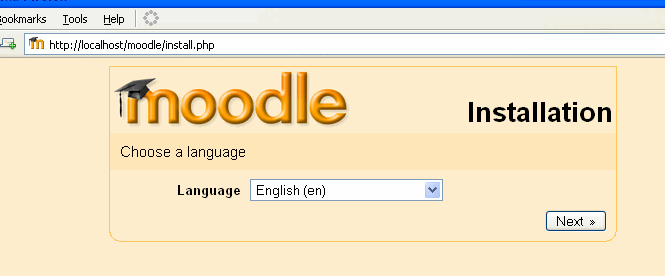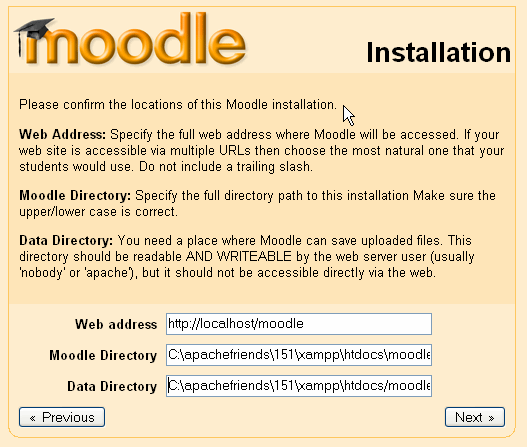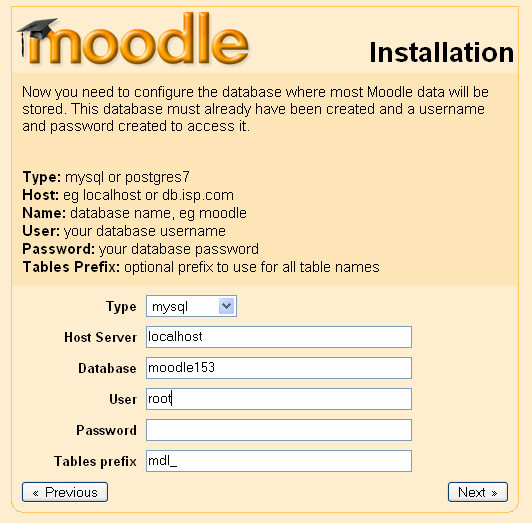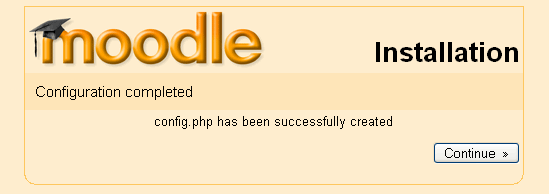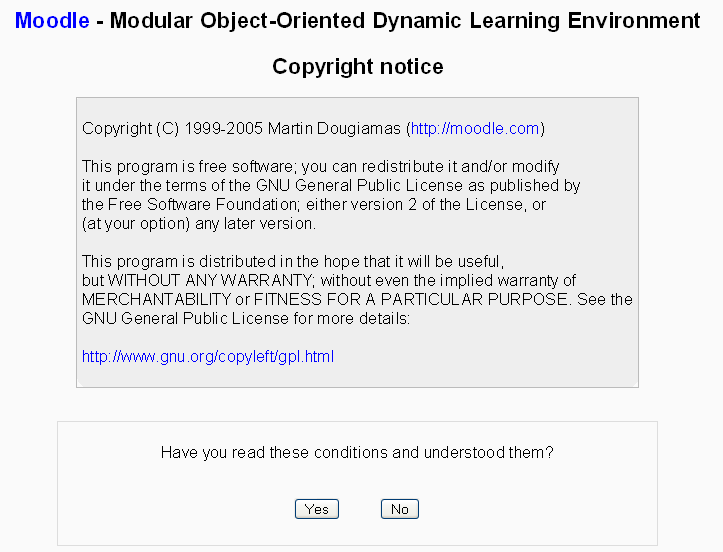Windows installation using XAMPP: Difference between revisions
Ray Lawrence (talk | contribs) |
(Reformat, add opening) |
||
| Line 1: | Line 1: | ||
XAMPP is built for tests or perhaps for a small company using it on an internal network. It is not meant for online access via the web on a production server. This page describes some of the ways to customize XAMPP. | |||
==Introduction== | |||
Note: This guide uses XAMPP 1.5.1 | Note: This guide uses XAMPP 1.5.1 | ||
| Line 14: | Line 13: | ||
'''Note: These guidelines are not intended for the Complete Install Package from Downloads at Moodle.org - although the troubleshooting part may help if you encounter problems.''' | '''Note: These guidelines are not intended for the Complete Install Package from Downloads at Moodle.org - although the troubleshooting part may help if you encounter problems.''' | ||
==Preparation== | |||
===Get Moodle!=== | |||
*Download the version of Moodle you wish to install from [http://download.moodle.org/ Moodle.org] | *Download the version of Moodle you wish to install from [http://download.moodle.org/ Moodle.org] | ||
| Line 22: | Line 21: | ||
[[Image: 14a.gif]]. | [[Image: 14a.gif]]. | ||
===Get XAMPP!=== | |||
*Download XAMPP for Windows from [http://www.apachefriends.org/en/xampp.html Apachefriends.org]. This example assumes that you have downloaded the “Installer” package. | *Download XAMPP for Windows from [http://www.apachefriends.org/en/xampp.html Apachefriends.org]. This example assumes that you have downloaded the “Installer” package. | ||
| Line 28: | Line 27: | ||
[[image:Xampp1.png]] | [[image:Xampp1.png]] | ||
===Allow yourself some time=== | |||
*Say 45 minutes. | *Say 45 minutes. | ||
==Installing XAMPP== | |||
*Run the installer, eventually you will be presented with an option about where to install the package. | *Run the installer, eventually you will be presented with an option about where to install the package. | ||
| Line 70: | Line 69: | ||
[[image:Xampp31.gif]] | [[image:Xampp31.gif]] | ||
==Create the database== | |||
*To create a database for your Moodle “site” we will use the phpMyAdmin utility included with XAMPP. | *To create a database for your Moodle “site” we will use the phpMyAdmin utility included with XAMPP. | ||
| Line 98: | Line 97: | ||
[[image:Xampp13.gif]] | [[image:Xampp13.gif]] | ||
==Extract the downloaded Moodle files to the correct location.== | |||
*Locate the file downloaded from Moodle.org and either copy or cut the file to the Windows clipboard. | *Locate the file downloaded from Moodle.org and either copy or cut the file to the Windows clipboard. | ||
| Line 122: | Line 121: | ||
[[image:Xampp19.gif]] | [[image:Xampp19.gif]] | ||
==Start the installation== | |||
*In your web browser, type the path to the folder containing the Moodle files in te address bar – in this example it’s <nowiki>http://localhost/moodle</nowiki>. | *In your web browser, type the path to the folder containing the Moodle files in te address bar – in this example it’s <nowiki>http://localhost/moodle</nowiki>. | ||
| Line 170: | Line 169: | ||
*Click the “Yes” button to continue, then follow the instructions on the following screens. | *Click the “Yes” button to continue, then follow the instructions on the following screens. | ||
==Troubleshooting== | |||
===Skype=== | |||
*If XAMPP does not work when you launch your browser and you have [http://www.skype.com Skype] enabled it may be necessary to change the port settings in Skype. | *If XAMPP does not work when you launch your browser and you have [http://www.skype.com Skype] enabled it may be necessary to change the port settings in Skype. | ||
| Line 192: | Line 191: | ||
===Still having problems but do not have Skype installed?=== | |||
* Check for another program which may be using port 80. IIS is commonly found to be the culprit. | * Check for another program which may be using port 80. IIS is commonly found to be the culprit. | ||
====Moodle Networking does not work==== | ====Moodle Networking does not work==== | ||
You may need to enable curl. Instructions at this link [http://www.tildemark.com/programming/php/enable-curl-with-xampp-on-windows-xp.html Enable curl in XAMPP on XP] | You may need to enable curl. Instructions at this link [http://www.tildemark.com/programming/php/enable-curl-with-xampp-on-windows-xp.html Enable curl in XAMPP on XP] | ||
==See also== | |||
*Return to [[Windows installation]] | |||
[[Category:Administrator]] | [[Category:Administrator]] | ||
[[Category:Installation]] | [[Category:Installation]] | ||
Revision as of 11:22, 24 March 2007
XAMPP is built for tests or perhaps for a small company using it on an internal network. It is not meant for online access via the web on a production server. This page describes some of the ways to customize XAMPP.
Introduction
Note: This guide uses XAMPP 1.5.1
In this guide to installing Moodle on a computer using the Windows XP operating system there are a series of steps you will need to take which are explained step-by-step below. In overview the process is as follows:
The first steps are to obtain the Moodle files themselves and the software package (XAMPP) which installs the environment (PHP, Apache and MySql) Moodle requires to run on you computer. When these have been downloaded you will need to install XAMPP on you computer in much the same way as any other Windows program. The steps detail a recommended change to one of the installed components before explaining how to launch XAMPP and create the database required by Moodle (the database you create will be referred to later when installing Moodle).
Having set up the environment you must then place the Moodle files downloaded earlier into the correct location so that they can be accessed for the purposes of initiating the installation process (now) and later to run Moodle. (The installation and use of Moodle is conducted entirely from you web browser e.g. Internet Explorer, Firefox).
Note: These guidelines are not intended for the Complete Install Package from Downloads at Moodle.org - although the troubleshooting part may help if you encounter problems.
Preparation
Get Moodle!
- Download the version of Moodle you wish to install from Moodle.org
Get XAMPP!
- Download XAMPP for Windows from Apachefriends.org. This example assumes that you have downloaded the “Installer” package.
Allow yourself some time
- Say 45 minutes.
Installing XAMPP
- Run the installer, eventually you will be presented with an option about where to install the package.
- In this example we are installing the package at c:\apachefriends\151 – that’s because it suits what our needs, you can choose you own location by specifying any suitable alternative folder.
- Continue with the installation, this will take a while!
- Eventually you will be presented with the option to install Apache, MySQL, Filezilla as a service.
- It’s probably best to choose “No” for now. You can always enable these as services later.
- Next you’ll be asked if you want to start the XAMPP Control Panel.
- Click the “No” button.
Launch XAMPP Control Panel
- On your Desktop, locate the XAMPP icon and double click to launch the Control Panel.
- When the XAMPP Control Panel has launched, click the “Start” buttons for Apache and MySQL.
- If all is well you will see something like this.
If Apache fails to run i.e. the "Running" text with the green background keeps disappearing) and you are using Skype - please review "Troubleshooting" at the end of these instructions.
Create the database
- To create a database for your Moodle “site” we will use the phpMyAdmin utility included with XAMPP.
- To access this launch the web browser of your choice (Firefox is used in this example), type http://localhost in the address bar.
- The XAMPP default page is displayed, click the link for your preferred language – we will be using English.
- From the menu on the left, click on “phpMyAdmin”
- When phpMy Admin has launched in your browser window, enter the name of your database in the “Create new database” field. In this example we are naming our database “moodle153”.
- Click the “Create” button to create the database.
The new database should be present in the dropdown list when the page has refreshed.
Extract the downloaded Moodle files to the correct location.
- Locate the file downloaded from Moodle.org and either copy or cut the file to the Windows clipboard.
- Open the XAMPP Control Panel and click on the “Explore” button.
- A Windows Explorer view similar to the one below will be displayed.
- Open the “htdocs” folder.
- Paste the file cut/copied earlier into this folder.
- Extract the Moodle files from the file downloaded earlier. A default folder named “moodle” is created with the Moodle files within.
Start the installation
- In your web browser, type the path to the folder containing the Moodle files in te address bar – in this example it’s http://localhost/moodle.
- The initial install page is displayed.
- Choose your preferred language (English is used in this example) and click the “Next” button.
- A diagnostic report is displayed – hopefully it will look like this, if not you may need to address some issues.
- Click the “Next” button to continue.
- The paths for your Moodle installation are shown – accept these or amend as desired.
- Click the “Next” button to continue.
- In this screen we enter the database settings. The fields are populated with some suggested values.
- In this example the database created is “moodle153”. The “root” user will be used without a password.
- DO NOT USE THE “ROOT” USER WITHOUT A PASSWORD FOR PRODUCTION INSTALLATIONS AS THIS CREATES A SECURITY VULNERABILITY
- When the fields have been populated, click the “Next” button to continue.
- Provided the Moodle folder is writable a message confirming the configuration has been completed will be displayed.
- Click the “ Continue” button to proceed.
The Moodle copyright / licence notices are displayed.
- Click the “Yes” button to continue, then follow the instructions on the following screens.
Troubleshooting
Skype
- If XAMPP does not work when you launch your browser and you have Skype enabled it may be necessary to change the port settings in Skype.
- Locate "Options..." in Skype.
- Locate the "Connection" options.
- Remove the tick / check from the Checkbox.
- Click the "Save" button.
- You may need to re-start your computer for this to take effect.
Still having problems but do not have Skype installed?
- Check for another program which may be using port 80. IIS is commonly found to be the culprit.
Moodle Networking does not work
You may need to enable curl. Instructions at this link Enable curl in XAMPP on XP
See also
- Return to Windows installation


